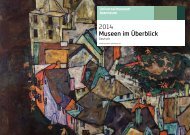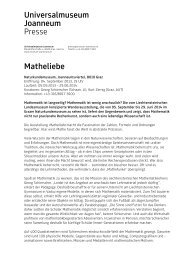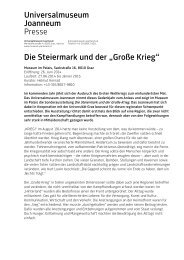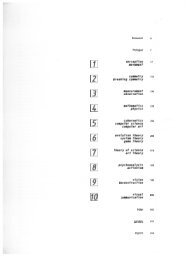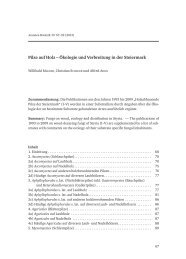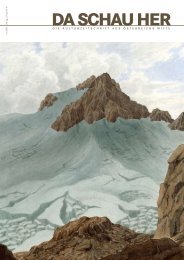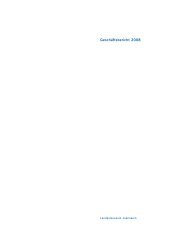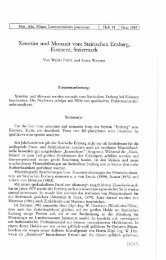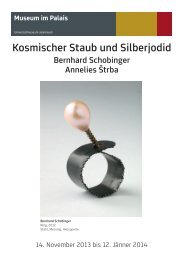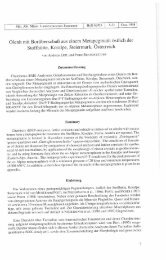Diana Thater gorillagorillagorilla - Universalmuseum Joanneum
Diana Thater gorillagorillagorilla - Universalmuseum Joanneum
Diana Thater gorillagorillagorilla - Universalmuseum Joanneum
Erfolgreiche ePaper selbst erstellen
Machen Sie aus Ihren PDF Publikationen ein blätterbares Flipbook mit unserer einzigartigen Google optimierten e-Paper Software.
<strong>gorillagorillagorilla</strong><br />
was filmed entirely on location in<br />
Mefou National Park, Cameroon in<br />
October-November, 2008.<br />
Front: Rachel Hogan with Shufai and<br />
Yeba. Behind: Appolinaire Nhoudou<br />
with Nona and Nkarla.<br />
Mefou National Park, Cameroon,<br />
October 2008, 35 mm photo<br />
<strong>gorillagorillagorilla</strong> depicts Western<br />
Lowland Gorillas (Trinomial name:<br />
Gorilla gorilla gorilla)<br />
Western Lowland Gorillas are found<br />
in Gabon, the Cabinda Enclave of<br />
Angola, the western part of the<br />
Republic of the Congo, the extreme<br />
southwestern part of the Central<br />
African Republic (CAR), south-central<br />
and southern Cameroon, and mainland<br />
Equatorial Guinea.<br />
Their current population is estimated<br />
to be 94,000. The Species<br />
Survival Commission of the World<br />
Conservation Union (IUCN) has<br />
categorized Western Lowland Gorillas<br />
as critically endangered overall, i.e.<br />
facing a very high risk of extinction in<br />
the wild in the near future.<br />
The work was made<br />
in cooperation with:<br />
The Cameroon Wildlife Aid Fund<br />
(CWAF)<br />
Rachel Hogan, Mefou National<br />
Park Manager<br />
Appolinaire Nhoudou, Gorilla Keeper,<br />
CWAF<br />
Alfred Kombele, Gorilla Keeper, CWAF<br />
The Apes of Mefou featured<br />
in this work:<br />
Avishag, Bobo, Djanga, Eto’o, Geri,<br />
Jasmin, Kibu, Miel, Myvi, Nkamun,<br />
Nkandaniel, Nkarla, Nona, Nyum,<br />
Pikin, Shai, Shufai, Yeba<br />
The Missions of the Cameroon<br />
Wildlife Aid Fund<br />
CWAF aims to ensure that<br />
Cameroon’s primates have a healthy<br />
future. Working with the government,<br />
local communities and other ecological<br />
groups around the world, we hope<br />
to show people the amazing diversity<br />
of wildlife in Cameroon, and explain<br />
exactly how and why it should be<br />
protected.<br />
Mefou National Park is situated about<br />
one hour from the centre of Yaounde.<br />
It contains 1,044 hectares of forest.<br />
At present we have eight electrified<br />
enclosures housing chimps, gorillas,<br />
baboons, and various species of<br />
monkeys.<br />
Bushmeat is the name given to wildlife<br />
that is hunted by people for food.<br />
Popular bushmeat includes gorillas,<br />
chimpanzees, elephants, monkeys,<br />
antelope, crocodiles, snakes and<br />
many others. Many of these animals<br />
are endangered, making it illegal<br />
to hunt them. In Central and West<br />
Africa between 3 and 5 million tons of<br />
bushmeat are killed each year.<br />
In Cameroon 60 % of the remaining<br />
17 million hectares (42 million<br />
acres) of forest are being exploited<br />
for logging and farming. 200,000<br />
hectares of forest are lost annually.<br />
Logging companies are instrumental<br />
in increasing the bushmeat trade.<br />
Logging companies have given hunters<br />
easy access to what was previously<br />
impenetrable forest by creating<br />
exploratory roads and tracks. Logging<br />
vehicles are often used to transport<br />
hunters into forest areas, and to bring<br />
out their kills and transport them to<br />
market.<br />
If nothing is done, in 10-15 years<br />
Cameroon will have no wild apes.<br />
CWAF relies on fundraising for its<br />
operating expenses.<br />
Donations:<br />
www.cwaf.org/adopt-an-orangutanendagered-gorillas.htm<br />
The Bristol Conservation and<br />
Science Foundation<br />
Neil Maddison, Head of Conservation<br />
Programmes<br />
The Bristol Conservation and Science<br />
Foundation carries out the society’s<br />
field conservation programmes in the<br />
wild and its conservation research<br />
programmes, both in the field and at<br />
Bristol Zoo Gardens. Our field programmes<br />
are each linked to exhibit<br />
areas in Bristol Zoo Gardens, and<br />
there will, in future, be links between<br />
exhibits at the National Wildlife<br />
Conservation Park and conservation<br />
and research programmes in the wild.<br />
In the field, the Bristol Conservation<br />
and Science Foundation works on<br />
projects where we have the skills<br />
and experience to make a significant<br />
difference through supporting wildlife<br />
conservation.<br />
www.bristolzoo.org.uk/about/<br />
conservation<br />
The United Nations Environment<br />
Programme<br />
Great Apes Survival Partnership<br />
(GRASP)<br />
The Great Apes Survival Partnership<br />
(GRASP) is an innovative and ambitious<br />
project of the United Nations<br />
Environment Programme (UNEP)<br />
and the United Nations Educational,<br />
Scientific and Cultural Organization<br />
(UNESCO) with an immediate challenge<br />
- to lift the threat of imminent<br />
extinction faced by gorillas<br />
(Gorilla beringei, G. gorilla), chimpanzees<br />
(Pan troglodytes), bonobos<br />
(Pan paniscus) and orangutans<br />
(Pongo abelii, P. pygmaeus) across<br />
their ranges in equatorial Africa and<br />
south-east Asia.<br />
www.unep.org/grasp<br />
142 143



